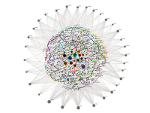 Outreach
Outreach
OUTREACH
Is the Voter Model a Model for Voters?
The voter model has been studied extensively as a paradigmatic opinion dynamics model. However, its ability to model real opinion dynamics has not been addressed. Investigators of Institute for Cross-Disciplinary Physics and Complex Systems, IFISC (CSIC/UIB) introduce a noisy voter model (accounting for social influence) with recurrent mobility of agents (as a proxy for social context), where the spatial and population diversity are taken as inputs to the model. This study shows that the dynamics can be described as a noisy diffusive process that contains the proper anisotropic coupling topology given by population and mobility heterogeneity. The model captures statistical features of U.S. presidential elections as the stationary vote-share fluctuations across counties and the long-range spatial correlations that decay logarithmically with the distance. Furthermore, it recovers the behavior of these properties when the geographical space is coarse grained at different scales—from the county level through congressional districts, and up to states. Finally, we analyze the role of the mobility range and the randomness in decision making, which are consistent with the empirical observations.
![]()
36 years of simulated US presidential election maps have some statistical properties that remain constant in time and are similar to the real election results. (Counties that voted for the Democrat are blue; those for the Republican are red. The intensity of the color indicates the margin of victory.)
This map shows connections between home and work counties for the most common connections (top 10%), according to census data. Researchers used these data as part of a simulation of voting behavior in US presidential elections.











